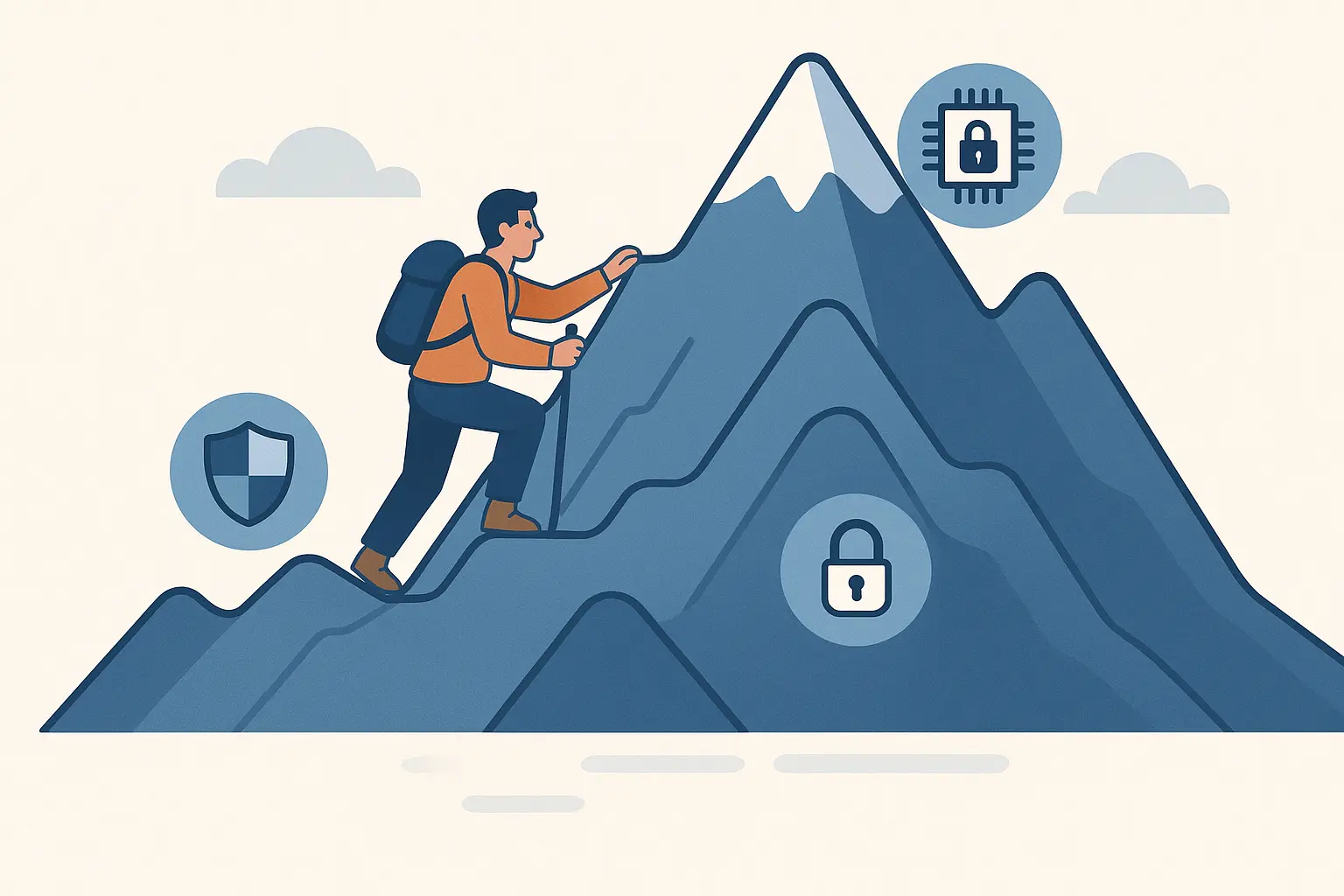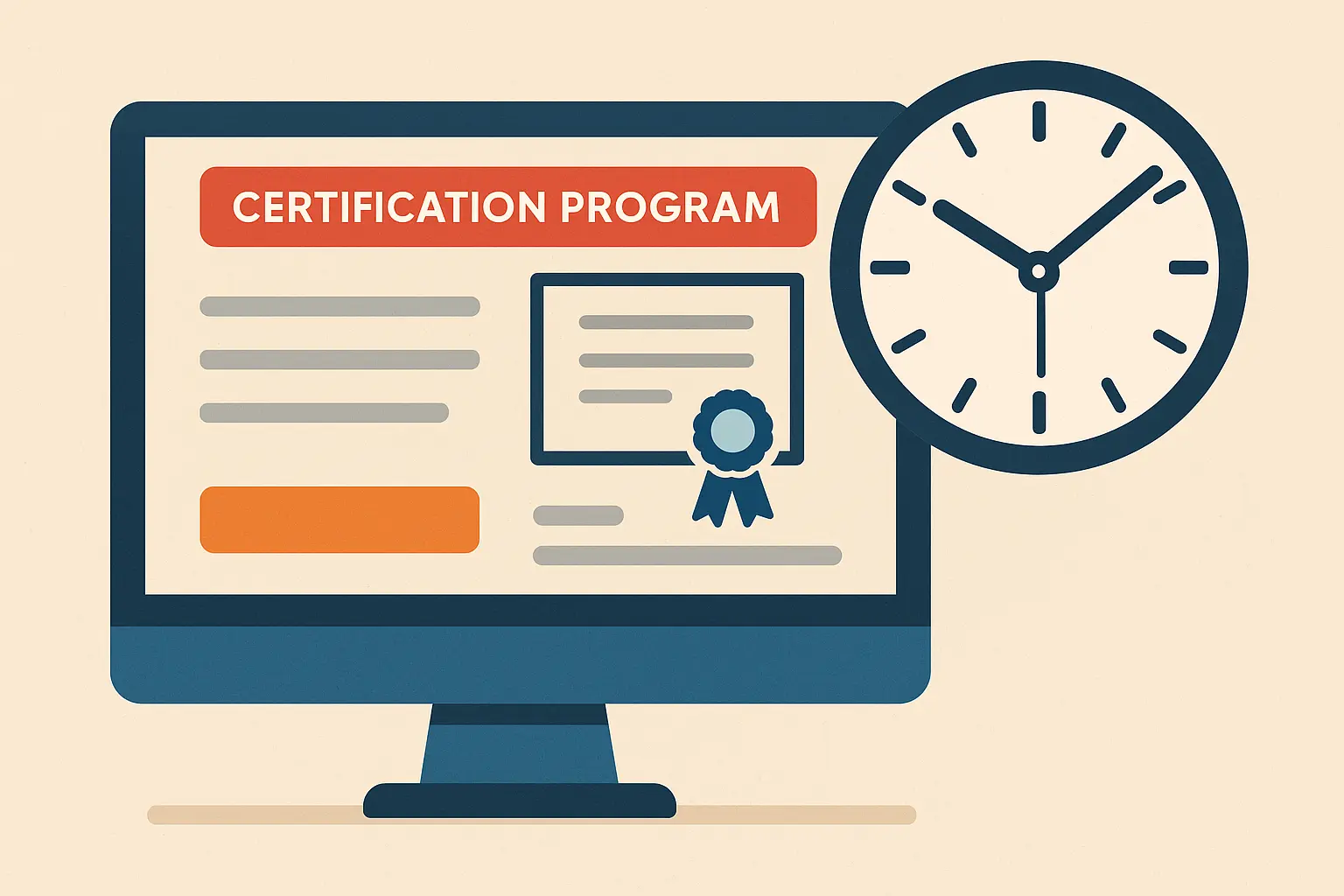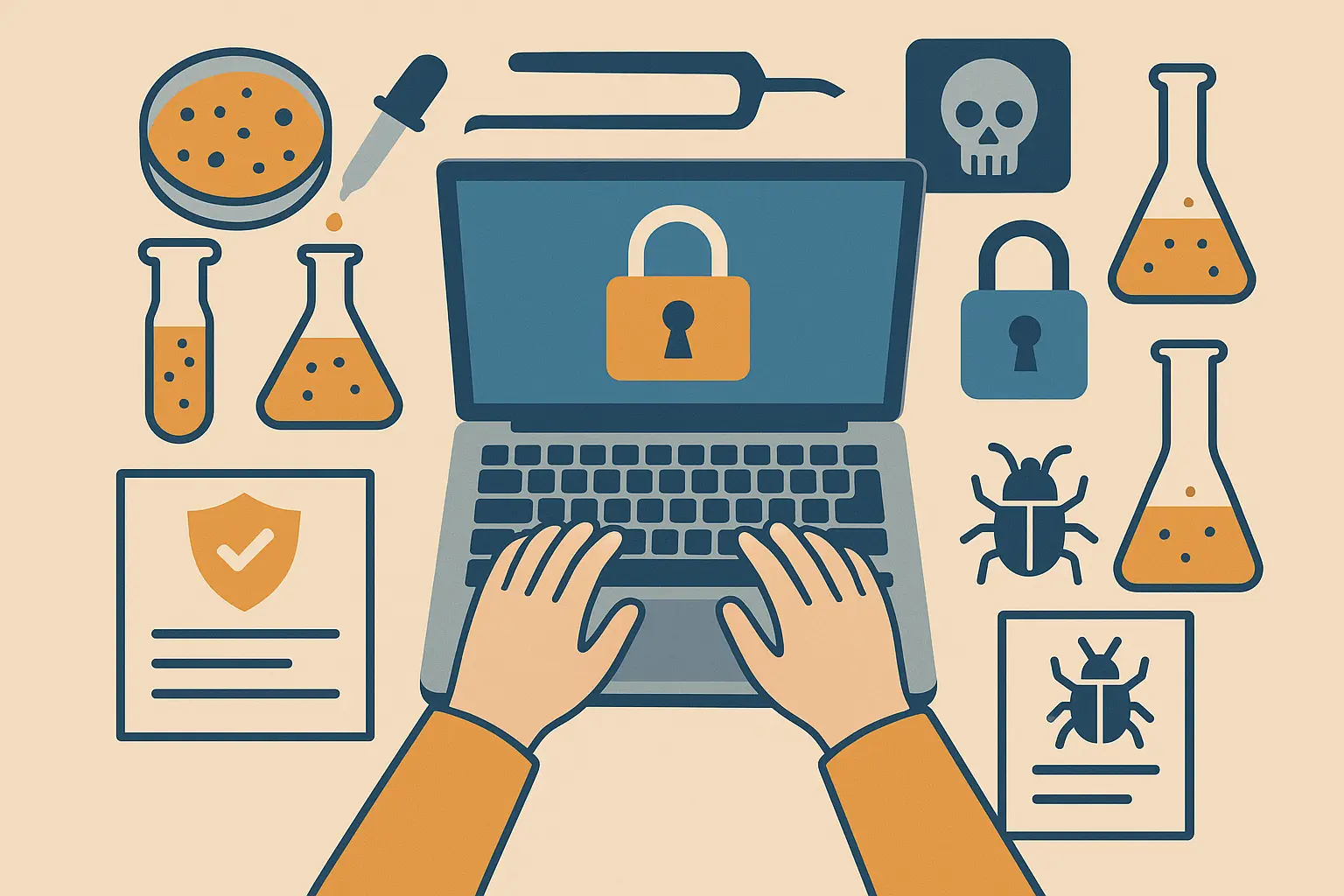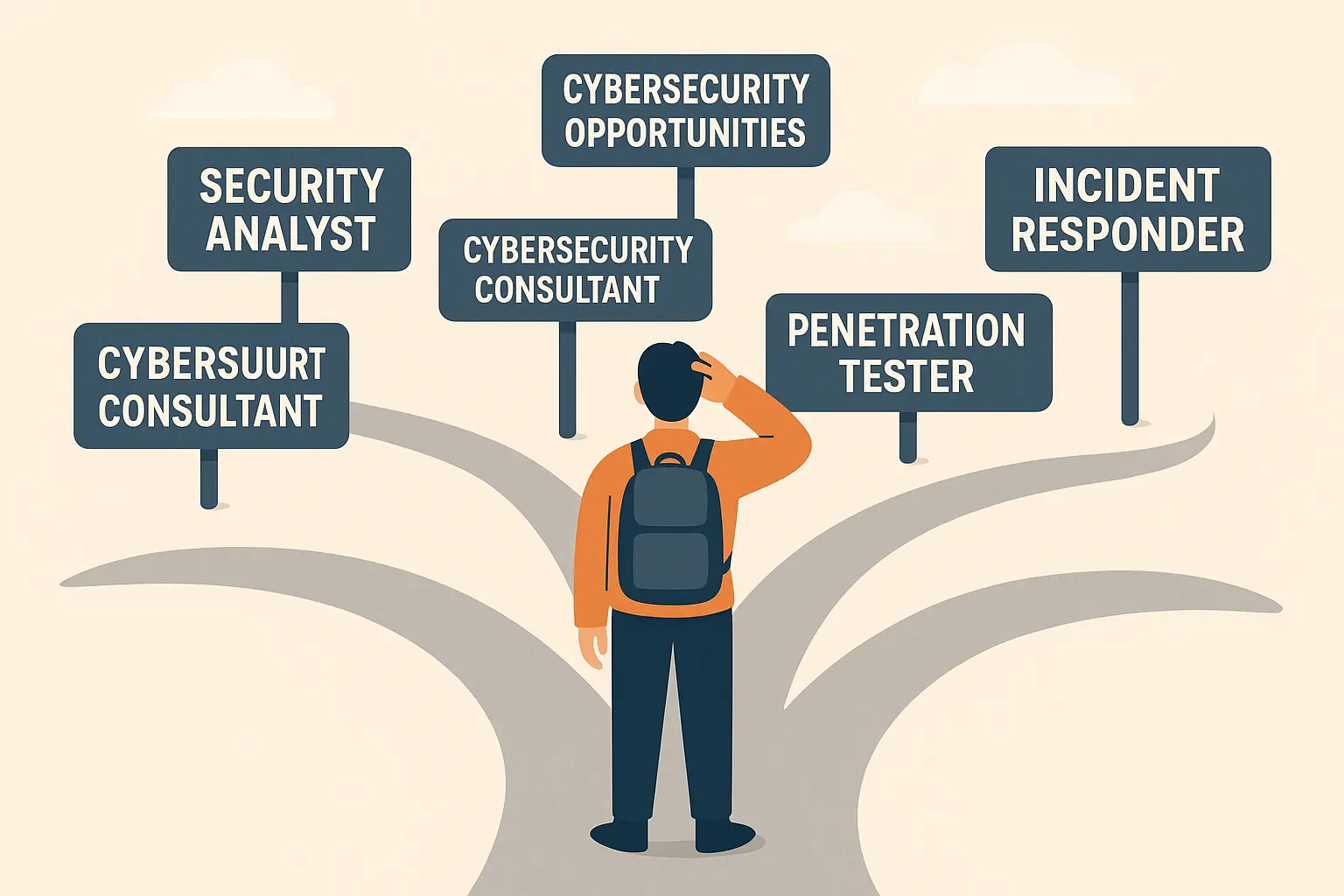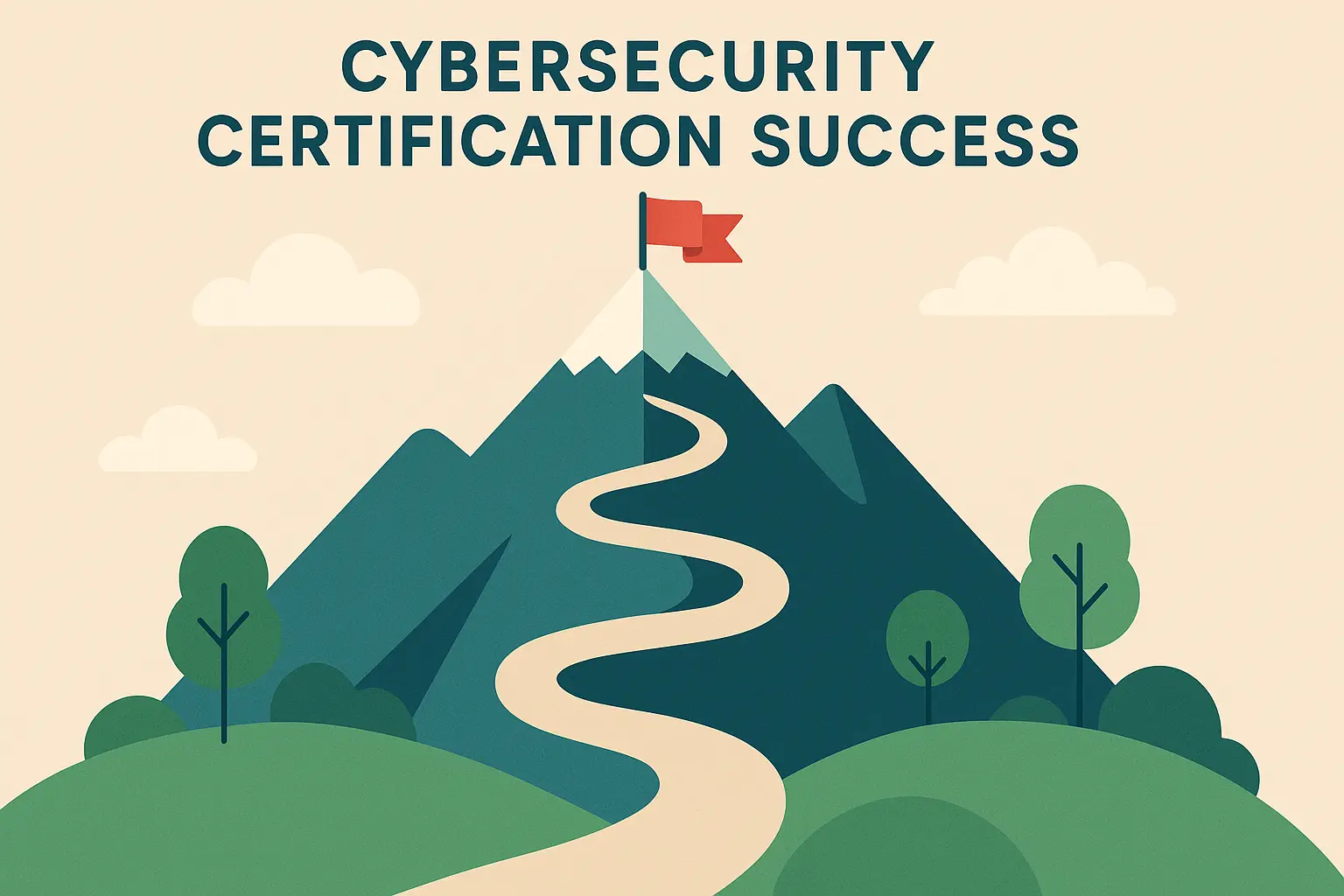Cybersecurity is absolutely exploding right now, with over 140,000 certified members in major certification bodies like (ISC)2 alone. But here’s what nobody warned me about – the reality of getting these certifications is nothing like those shiny marketing timelines. We’re talking years, not months, and it touches every part of your life in ways that’ll surprise you.
I’ve been through this journey myself, and let me tell you what nobody talks about. The psychological rollercoaster, the financial stress, the family negotiations – it’s all part of the package. I’ll walk you through the real timeline of cybersecurity certification, complete with the messy, human parts that marketing materials conveniently skip.
Understanding how long it takes to get a certificate in general can help you wrap your head around what you’re really signing up for here.
Table of Contents
-
The Mental Game: Your Psychological Journey Through Certification
-
Money Talks: The Economic Reality of Certification Timing
-
Google’s Cybersecurity Certificate: Marketing vs. Reality
-
After the Certificate: The Career Launch Timeline
-
Final Thoughts
TL;DR
-
You’ll spend 2-6 months just getting your head right before you even touch a book
-
Money problems will probably double or triple whatever timeline you’re imagining
-
That Google Cybersecurity Certificate? Plan on 8-18 months, not the 3-6 they advertise
-
“Self-paced” sounds awesome until you realize you’re your own worst enemy
-
Landing a job after certification can take another 3-12 months of hustle
-
Career changers need extra time to build confidence and basic tech skills
-
Family life and work schedules will mess with your plans in ways you can’t predict
The Mental Game: Your Psychological Journey Through Certification
Here’s what hit me hardest – the mental game. Nobody talks about the 2 AM anxiety spirals where you’re googling “am I too old to switch careers?” for the hundredth time. The emotional stuff around getting certified will mess with your timeline more than any technical concept ever will.
Getting Your Head in the Game Before You Start
Most people don’t realize you need a whole preparation phase before you even crack open a book. I’m talking about the weeks (or months) you’ll spend staring at job postings, questioning your life choices, and trying to figure out if you can actually pull this off. This phase alone can add 2-6 months to your timeline.
Should I Really Do This? The Career Pivot Contemplation
You know that feeling when you’re standing at the edge of a major life change? That’s exactly where I found myself. I spent two months (okay, maybe closer to three) diving deep into salary research, reading day-in-the-life posts on Reddit, and questioning whether I could handle getting called at 2 AM about security incidents.
Career changers typically spend 3-8 weeks just researching whether cybersecurity actually fits their personality and lifestyle. It’s not just browsing job boards – you’re trying to figure out if you can mentally handle the constant learning curve, the pressure of protecting company data, and whether your family will understand why you’re suddenly obsessed with network security.
Sarah’s Story: A teacher from Ohio spent 3 months researching cybersecurity careers before even signing up for the Google Certificate. She attended virtual meetups, interviewed professionals on LinkedIn, and even shadowed a SOC analyst for a day. Yeah, it extended her timeline, but it gave her confidence that cybersecurity was actually the right fit for her analytical brain and need for constant learning.
Getting Your Life Together: Financial and Logistics Planning
Here’s the thing nobody tells you – you can’t just decide to get certified and start studying tomorrow. I had to negotiate with my spouse about taking over evening kid duties, figure out how to carve out weekend study time, and honestly assess whether we could afford the exam fees and potential income hit.
Before you can even think about studying, you need 2-4 weeks to arrange study schedules, maybe reduce work hours, and budget for all the costs nobody mentions upfront. The logistics get complicated fast. Can you actually study effectively after a 10-hour workday? Do you have a quiet space at home? Will your boss let you take time off for exams?
Pre-Study Reality Check:
-
Figure out your money situation and budget for everything (it’s more than you think)
-
Have some serious conversations with your family about study time
-
Set up a dedicated study space (even if it’s just a corner of your bedroom)
-
Research when and where you can actually take exams
-
Look at your work schedule and be honest about flexibility
-
Plan for potentially making less money during intensive study periods
-
Find people who’ll keep you accountable when motivation tanks
Am I Smart Enough for This? Technology Comfort Assessment
Let’s be real – if you’re coming from a non-tech background, you might need 1-3 months just getting comfortable with basic computer stuff before you can tackle security concepts. I watched my friend spend two months just getting familiar with command lines and understanding how networks actually work.
This isn’t about intelligence; it’s about familiarity. If terms like “IP address,” “firewall,” and “encryption” make you nervous, you’ll need time to build that foundation. Don’t skip this step – trying to learn advanced security concepts without basic tech literacy is like trying to read Shakespeare when you’re still learning the alphabet.
The Confidence Rollercoaster: Building Belief in Yourself
Even after months of studying, that little voice in your head will keep saying, “But what if I don’t know enough?” This confidence game will mess with your timeline in ways that have nothing to do with your actual knowledge.
That Voice in Your Head: Imposter Syndrome Extension
I postponed my exam three times because I kept thinking I wasn’t ready. Spoiler alert: I was technically ready, but mentally? Not even close. Many people delay scheduling exams for 2-6 weeks beyond when they’re actually prepared, just because of self-doubt.
Imposter syndrome hits different in cybersecurity because the stakes feel so high. You’re not just worried about failing a test – you’re worried about being responsible for protecting sensitive data and not being “technical enough” for the role. Women and career changers seem to struggle with this more, often studying 40-50% longer than necessary because they don’t trust their own knowledge.
According to “Dice’s research on cybersecurity careers”, certified professionals earn 15-20 percent more on average than their non-certified counterparts, yet many still question their readiness even after getting certified.
Better Safe Than Sorry: The Over-Preparation Safety Net
I took practice exams until I could score 95% consistently, even though passing only required 70%. Why? Because failing felt like it would confirm every doubt I had about changing careers. This over-preparation added about six weeks to my timeline, but it felt necessary for my peace of mind.
The practice test addiction is real. You tell yourself “just one more” until you’ve taken the same practice exam five times. While some review is essential, there’s a point where you’re just procrastinating the real thing out of fear. But honestly? Sometimes you need that extra confidence boost, even if it extends your timeline.
Making It Work with Real Life: Social and Family Integration
Getting your family on board took longer than I expected. My kids didn’t understand why I suddenly couldn’t help with homework every night, and my partner felt overwhelmed picking up the slack. We needed several family meetings to figure out a schedule that worked for everyone.
Family Meeting: Schedule Negotiation
Parents and caregivers typically need 2-4 weeks just to establish sustainable study routines that don’t destroy family relationships. The guilt is real when you’re studying while your family watches Netflix together. You have to actively work to maintain relationships during this intense period, which means your study time gets chopped up and extended.
|
Family Role |
What You’ll Deal With |
Time Impact |
What Actually Works |
|---|---|---|---|
|
Single Parent |
No quiet time, constant interruptions |
+6-12 months |
Study during school hours, arrange childcare swaps |
|
Primary Breadwinner |
Can’t cut work hours |
+4-8 months |
Weekend/evening grind, use vacation time for exams |
|
Caregiver (elderly) |
Unpredictable schedule |
+3-9 months |
Flexible study plan, backup care arrangements |
|
Working Parent |
Everything competes for attention |
+3-6 months |
Early morning study, family schedule coordination |
Explaining Your Dreams: Social Circle Education and Support Building
“Wait, you’re leaving teaching to do… computer security?” I had this conversation about fifty times with friends and family. Everyone had opinions about my career change, and honestly, some weren’t supportive. Building a support network and educating people about what cybersecurity actually involves takes time and emotional energy.
You’ll spend 1-2 months explaining career changes to family and friends, seeking support, and managing everyone’s expectations around your certification journey. You’ll find yourself becoming a cybersecurity evangelist, explaining why the field matters and defending your decision to change careers.
Money Talks: The Economic Reality of Certification Timing
Let’s talk money – because that’s the elephant in the room nobody wants to mention. Most of us can’t just quit our jobs to study full-time like those success stories you see on LinkedIn. Financial reality is probably the biggest factor that’ll mess with your timeline.
When Every Dollar Counts: The Paycheck-to-Paycheck Study Extension
If you’re like most working adults, you can’t afford to cut your income for intensive study. This forces you into part-time learning that stretches those advertised 3-6 months into a more realistic 8-18 months.
Recent industry reports from “Simplilearn’s cybersecurity market analysis” show the global cybersecurity training market was valued at USD 4.53 billion in 2023, projected to grow at a CAGR of 17.4% between 2024 and 2030. That’s a lot of money flowing around, but it doesn’t make your personal budget any bigger.
Brain Dead After Work: Evening and Weekend Learning Limitations
By 7 PM, my brain feels like mush. Trying to understand network protocols after a demanding workday? Forget about it. What should’ve taken me an hour to grasp during fresh morning hours stretched into three-hour evening sessions where I’d read the same paragraph five times.
Weekend study sessions aren’t much better when you’re cramming in errands, family time, and trying to maintain some semblance of work-life balance. I found myself studying in 30-minute chunks between grocery shopping and soccer practice, which isn’t exactly optimal for retaining complex security concepts.
Many professionals facing similar challenges end up needing replacement certifications when their original documents get lost during the extended study period – just another thing to keep track of during this crazy time.
Saving Up for Success: The Exam Fee Savings Period
Here’s an uncomfortable truth: exam fees aren’t pocket change. When you’re already stretching your budget to accommodate reduced income for study time, dropping $300-500 on exam fees requires planning. I had to save for three months just to afford my certification exam, even though I’d finished studying weeks earlier.
The waiting period while saving for exam fees is mentally exhausting. You’re worried about forgetting material while you wait, but you literally can’t afford to test yet. Some people take out credit card debt for exam fees, which creates additional financial stress during an already challenging time.
|
Certification |
Exam Fee Range |
Study Materials Cost |
Lab Equipment |
Total Investment |
|---|---|---|---|---|
|
CompTIA Security+ |
$370-$400 |
$150-$300 |
$200-$500 |
$720-$1,200 |
|
Google Cybersecurity |
$39-$49/month |
$0-$100 |
$300-$800 |
$400-$1,200 |
|
CISSP |
$749 |
$200-$500 |
$500-$1,500 |
$1,449-$2,749 |
|
CEH |
$1,199 |
$300-$600 |
$400-$1,000 |
$1,899-$2,799 |
Building Your Lab: Equipment and Software Investment Timeline
Nobody warned me that I’d need to gradually build a home lab setup. Virtual machines, software licenses, and decent hardware don’t come free. I spent six months slowly acquiring the tools I needed for hands-on practice, buying one piece at a time when I could afford it.
The equipment timeline directly impacts your learning progression. You can’t practice incident response without the right tools, but you also can’t drop $2,000 on lab equipment overnight. This creates a frustrating stop-and-start learning pattern that stretches your timeline significantly.
Playing It Smart: The Income Replacement Strategy
Getting certified is just the beginning. I spent an additional eight months building projects, contributing to open-source security tools, and documenting everything for my portfolio. This wasn’t optional – employers wanted to see practical application of my certification knowledge.
Side Hustle Security: The Skill-Building Project Phase
Building a portfolio of cybersecurity projects while working full-time extends the practical application phase by 6-12 months beyond basic certification completion. The project phase happens parallel to your day job, which means you’re essentially working two jobs.
Weekends become coding sessions, evenings turn into vulnerability assessment practice, and vacation days get used for cybersecurity conferences. It’s exhausting but necessary for career transition success.
Mike’s Portfolio Journey
Mike’s Portfolio Journey: A retail manager from Texas spent 10 months after completing his Security+ certification building a home lab, documenting vulnerability assessments, and creating incident response playbooks. He worked 20 hours per week on projects while maintaining his full-time job, ultimately landing a SOC analyst position that paid $15,000 more than his retail management role.
Making Connections: The Network Building Investment
LinkedIn became my second job. I spent months engaging with cybersecurity professionals, commenting thoughtfully on posts, and attending virtual meetups. Building genuine professional relationships takes 6-18 months of consistent effort – you can’t just connect with someone and immediately ask for job referrals.
The networking timeline often determines your post-certification job search success more than your actual technical skills. I watched friends with weaker technical knowledge land jobs faster because they’d invested more time in relationship building. It’s not fair, but it’s reality.
Google’s Cybersecurity Certificate: Marketing vs. Reality
So you’re thinking about the Google Cybersecurity Professional Certificate because it promises 3-6 months to career change? Let me tell you what actually happens when real people with real lives try to make this work.
The European Union’s recent implementation of “mandatory externally verified cybersecurity certificates” through the EU Common Criteria (EUCC) and Cyber Resilience Act shows that cybersecurity credentials are becoming more important globally, making programs like the Google cert increasingly valuable.
The Freedom Trap: Self-Paced Paradox
Self-paced sounds amazing until you realize you’re your own worst enemy. Without external deadlines, most of us experience significant motivation dips that can extend completion time by 3-9 months beyond initial projections.
Motivation Rollercoaster: The Maintenance Challenge
I started strong, completing modules ahead of schedule, then hit a motivation wall around month four. Without professors or classmates holding me accountable, I went three weeks without opening the course material. Sound familiar?
The motivation dips are predictable but brutal. You’ll cruise through easy modules, then hit complex topics like cryptography or incident response and suddenly find excuses to avoid studying. Netflix becomes very appealing when you’re struggling with network security concepts.
The Google cert’s flexibility becomes a double-edged sword – while you can learn at your own pace, maintaining consistent momentum requires exceptional self-discipline that most working adults struggle to sustain over extended periods.
Course Hopping: The Sequence Optimization Problem
I repeated the network security module three times because I didn’t feel confident moving forward. The course structure allows this flexibility, but it also enables perfectionist tendencies that stretch your timeline unnecessarily. When should you move on? How much is “enough” understanding?
Taking breaks between courses seemed harmless until I realized I’d forgotten half of what I learned in earlier modules. The lack of structured progression means you’re constantly making decisions about pacing, and most people err on the side of caution (which means slower completion).
Getting Your Hands Dirty: Practical Application Integration Timeline
The certificate’s hands-on components require additional time for concept internalization and practical skill development that varies dramatically based on your prior technical experience and learning style.
Tech Troubles: Lab Environment Setup and Troubleshooting
The hands-on labs looked straightforward in the course videos, but setting up my own environment was a nightmare. I spent two weeks just getting virtual machines configured properly, troubleshooting network connectivity issues, and figuring out why my security tools weren’t working as expected.
Technical setup issues and learning curves for lab environments typically add 2-6 weeks to the practical learning components, especially if you don’t have a strong technical background. Technical troubleshooting isn’t part of the official curriculum, but it’s a huge part of the real experience. You’ll spend hours googling error messages, posting in forums, and feeling frustrated that something “simple” isn’t working.
The Google cybersecurity professional certificate assumes a level of technical comfort that many career changers simply don’t possess, creating hidden time investments in basic IT skills development.
Bridging the Gap: Real-World Application Bridge
The course teaches you concepts, but applying them in realistic scenarios takes additional work. I spent four months after completing the certificate working through real-world scenarios, practicing with different tools, and building confidence in my practical abilities.
Translating course concepts into job-ready skills requires additional practice and project development, typically extending timelines by 2-8 months beyond course completion. Employers don’t just want certificate holders – they want people who can actually do the job. This means you need to go beyond the course material, practice with industry-standard tools, and develop troubleshooting skills that only come with hands-on experience.
Industry Context: The Specialization Research Phase
Healthcare cybersecurity is different from financial services security, which is different from government security. I spent two months researching my target industry, understanding specific compliance requirements, and learning industry-specific terminology that wasn’t covered in the general certificate program.
Understanding how course material applies to specific industry sectors requires additional research and networking, adding 1-3 months to career preparation timelines. The course provides broad cybersecurity knowledge, but you’ll need to specialize for specific job applications. This industry research phase is crucial for interview success but adds significant time to your overall preparation timeline.
Jennifer’s Industry Specialization: After completing the Google Certificate, Jennifer spent 3 months researching healthcare cybersecurity, learning HIPAA compliance requirements, and networking with healthcare IT professionals. She attended virtual healthcare security conferences and joined specialized LinkedIn groups, which helped her land a security analyst role at a major hospital system.
After the Certificate: The Career Launch Timeline
So you’ve got your certificate – congratulations! Now comes the part nobody really prepares you for: actually landing a job. This phase often takes longer than getting the certificate itself, involving job market navigation, skill refinement, and learning how to sell yourself professionally.
Job Hunt Reality: The Market Navigation Period
Here’s the thing about entry-level cybersecurity positions – they require strategic application approaches, interview preparation, and often additional skill development that can extend your career transition by 3-12 months post-certification.
According to “Simplilearn’s industry analysis”, there are currently 3.5 million unfilled cybersecurity roles globally with 700,000 available job roles, yet many new certificate holders still struggle to land their first position due to experience requirements and market competition.
Cracking the Code: Application Strategy Development
Writing a resume that translates your certificate into employer value took me a month of iterations. How do you describe hands-on lab experience when you’ve never worked in cybersecurity? How do you position career change as a strength rather than a risk?
Learning to effectively communicate certification value to employers requires 2-6 weeks of resume optimization, LinkedIn profile development, and application strategy refinement. LinkedIn optimization became its own project. I rewrote my profile six times, learned about cybersecurity keywords for applicant tracking systems, and figured out how to network professionally without seeming desperate.
The Google cybersecurity cert provides technical knowledge, but translating that into compelling job applications requires separate skill development that many graduates underestimate.
Job Application Reality Check:
-
Tailor your resume for each cybersecurity role (yes, every single one)
-
Optimize LinkedIn profile with industry keywords
-
Create a portfolio showcasing certification projects
-
Research company-specific security challenges
-
Practice explaining your career transition story
-
Prepare for technical interview scenarios
-
Build a list of target companies and contacts
-
Set up job alert notifications (and prepare for rejection)
Understanding is a certificate a degree becomes crucial when explaining your qualifications to employers who may not be familiar with professional certification programs.
Proving Yourself: Interview Skill Development
Mock interviews revealed gaps in my knowledge that the certificate didn’t address. I could explain security concepts in theory, but discussing real-world implementation with experienced professionals exposed my lack of practical experience. I spent two months practicing technical interviews and building confidence in my communication skills.
Technical interview preparation and developing confidence in discussing cybersecurity concepts with experienced professionals requires 1-3 months of focused practice and skill refinement. The interview preparation phase involves learning to think on your feet, explaining complex concepts simply, and demonstrating problem-solving approaches. These soft skills are crucial but require separate development time beyond technical certification study.
Putting It All Together: Credential Verification and Documentation
Organizing and presenting certification credentials professionally often reveals gaps in documentation and presentation that require additional time investment for career readiness.
Show Your Work: Portfolio Development Phase
Building a portfolio that showcases your skills takes serious time. I spent six weeks documenting projects, creating case studies, and developing presentations that demonstrated my practical application of certification concepts. Employers want to see your thinking process, not just your final results.
Creating a professional portfolio that demonstrates practical application of certification knowledge requires 1-2 months of project documentation and presentation development. The portfolio development phase forces you to articulate your learning and connect theoretical knowledge to practical applications. This reflection process is valuable but time-consuming, especially when you’re trying to present beginner-level projects in a professional manner.
Portfolio Development That Actually Works:
-
Project Overview (what you actually did, not what you think sounds impressive)
-
Technical Challenge (the specific problem you solved)
-
Tools and Methods Used (detailed breakdown of your approach)
-
Implementation Process (step-by-step, including the messy parts)
-
Results and Impact (measurable outcomes, even if small)
-
Lessons Learned (what you’d do differently next time)
-
Supporting Documentation (screenshots, code snippets, reports)
Many professionals discover they need replacement diplomas or certificates during the job application process when original documents are damaged or misplaced during the extended certification timeline.
How ValidGrad Can Help
Sometimes life throws curveballs during your certification journey. Whether you’ve completed your Google Cybersecurity Professional Certificate but need replacement documentation due to loss, damage, or immediate professional requirements, ValidGrad provides practical solutions to keep your career momentum moving forward.
We get it – the extended timeline of cybersecurity certification often spans 1-3 years for complete career transition, which means having reliable access to your certification documentation becomes crucial for maintaining professional opportunities. Don’t let administrative delays mess with your hard-earned progress.
If you’re wondering how to display certificates on wall once you’ve completed your cybersecurity certification, proper presentation can enhance your professional credibility during the job search phase.
Final Thoughts
The reality of cybersecurity certification timelines is messier than any marketing promise. It involves complex personal, financial, and professional considerations that can span years rather than months. But here’s the thing – everyone’s journey looks different, and that’s totally normal.
Getting a cybersecurity certificate isn’t just about study hours and exam fees. It’s a comprehensive life change that touches every aspect of your routine, relationships, and financial planning. That Google Cybersecurity Professional Certificate might advertise 3-6 months, but real people with real responsibilities typically need 8-18 months just for the certificate, plus additional time for career transition.
Your timeline will be unique based on your background, financial situation, family responsibilities, and career goals. Don’t feel discouraged if you’re taking longer than advertised – you’re not behind, you’re being realistic about the complexity of career change in a demanding field.
This whole process is messier than anyone admits. Your timeline will be weird and non-linear, and that’s completely normal. Some weeks you’ll make zero progress and feel terrible about it. But here’s the thing – everyone feels this way, and most of us make it through.
The investment is worth it, but go in with eyes wide open about the true time commitment. Plan for the psychological journey, budget for the extended timeline, and remember that the people who make it aren’t necessarily the smartest – they’re the ones who don’t quit when it gets messy.
For those considering alternative paths, understanding certificates vs diplomas can help clarify the value proposition of professional certifications versus traditional degree programs in the cybersecurity field.
You’re not behind if you’re taking longer. You’re being human. Your cybersecurity career is a marathon, not a sprint, and every step forward counts.


